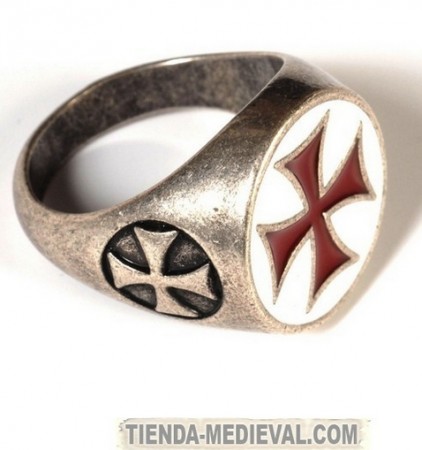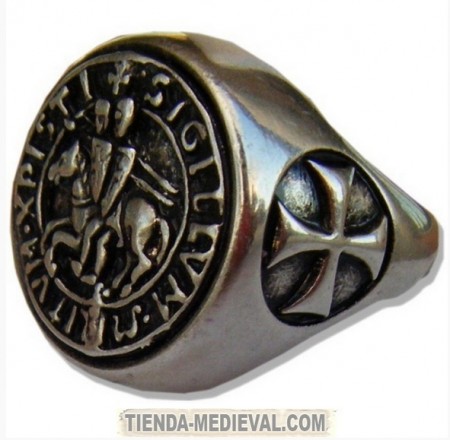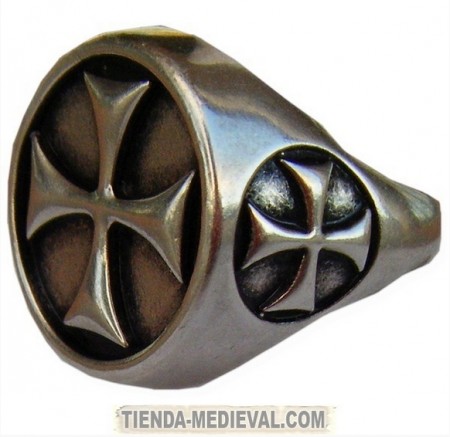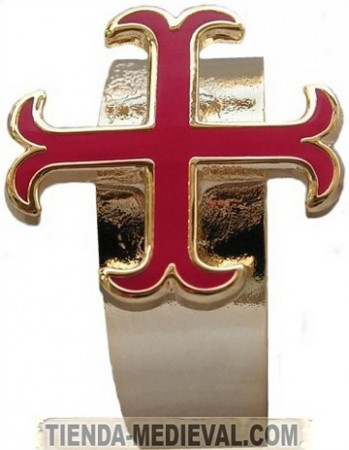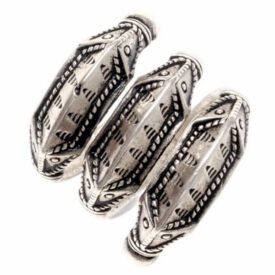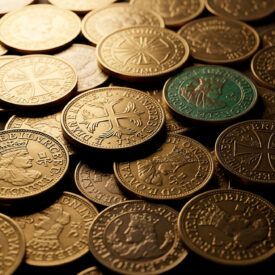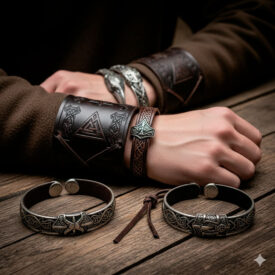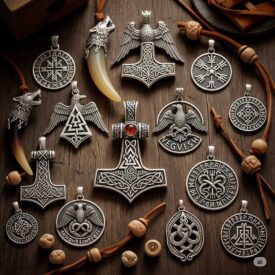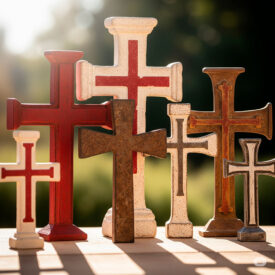Have you ever wondered about the jewelry that adorned hands in the Middle Ages? Beyond mere ostentation, medieval rings were powerful emblems, bearers of authority, identity, and at times even supposed magical powers. In this journey through time, we will explore their fascinating history and unveil the enigmatic relationship between these objects and the legendary Order of the Temple. The Knights Templar ring is a distinctive sign of great meaning and beauty, perfectly complementing Templar attire. The Templars were monk-soldiers: Guardians of the Faith, Guardians of the Holy Land, Guardians of Men.
Rings in the Middle Ages: Beyond Adornment
Since time immemorial, rings have been much more than mere ornaments. Their history dates back to ancient civilizations, where their function went beyond aesthetics to encompass the practical, the symbolic, and the mystical. As early as ancient Mesopotamia, around 3500 BC, cylindrical seals inscribed with personal designs evolved to be worn as rings, serving as instruments of authentication and document validation in an era when literacy was limited. These early signet rings were crucial for trade and administration, marking property and the authority of their bearer. In Egypt, around 2000 BC, rings became status symbols for pharaohs and officials, used not only to seal official and private documents but also to reflect the social position and divine power of their wearers. They were often made of gold and adorned with scarabs, symbols of rebirth and protection. Greeks and Romans, for their part, elevated signet rings to the category of art, with intricate designs engraved on precious stones that left a distinctive impression in wax. They were used by merchants, military leaders, and senators as an unequivocal sign of authority and belonging to the elite, and their design often reflected the personality or lineage of their owner. The evolution of the ring from a mere utilitarian object to a piece of jewelry with deep meaning is a testament to its cultural importance throughout history.
Who Wore Rings? Symbols of Power and Status
As we delve into the Middle Ages, the landscape of ring use in Christian Europe becomes surprisingly restrictive. Contrary to what one might think, searching for rings in sculptural representations or Christian paintings from this period is almost fruitless. Medieval iconography, so rich in details about clothing and attributes, rarely shows lay figures wearing rings. The only notable exception were bishops or popes, who wore them over white gloves as a symbol of their spiritual authority and their union with the Church, a “fisherman’s ring” representing their role as successors of Saint Peter. Very late, in the 15th century, we can find some representation, such as a Virgin in an alabaster sculpture with a small ring, a queen’s seal, indicating a gradual change in customs. It was not until well into the Renaissance that laypeople began to wear rings popularly, first in Italian or Flemish paintings, where growing opulence and interest in personal adornment became evident. The reason for this absence and subsequent restriction? The immense power and symbolic meaning that rings represented. Only high prelates or nobles of great lineage had the right to wear them, as they were considered insignia of their rank and authority. Ordinances were even issued at the end of the 14th century, such as those of Cervera in 1344 or Barcelona in 1376, prohibiting the population, especially women, from wearing precious stones or rings, seeking to control ostentation and maintain social hierarchies. Rings, therefore, were not just accessories, but a declaration of status and a privilege reserved for a few.
The Fear of Rings: Witchcraft and Amulets
The strict prohibition of ring use in the Middle Ages was not only due to Christian austerity or the need to maintain social distinctions, but also to a deep belief in the magical power attributed to them. In a society where superstition and faith were intertwined, any object with strong symbolism could be viewed with suspicion if it did not conform to ecclesiastical norms. Jews and Moors, who did use rings profusely, clearly distinguished between seals (with a well-defined legal and commercial use) and amulet rings, which often bore written blessings, cabalistic inscriptions, or precious stones with specific properties. Christians, upon observing the mysterious Hebrew or Arabic inscriptions and the use of the Kabbalah in these communities, attributed hidden powers to them, often linked to witchcraft, necromancy, or practices considered heretical.
Fascination and fear of the unknown fueled these suspicions. Set stones, in particular, were believed to introduce their bearers to the realm of necromancy and alchemy, disciplines that sought to manipulate the forces of nature and spirit. Treatises such as “On the Wonderful Properties of Precious Stones” by Gaspar de Morales (1598) detailed the symbolism and virtues attributed to specific gems: pearls were believed to protect against the plague, diamonds were considered protectors against bad dreams and ghosts, and were thought to verify chastity. The ruby, for its part, was considered a “queen” stone with tremendous spiritual forces, even present in papal tiaras, demonstrating the duality of its perception: a symbol of sacred power and, at the same time, an object of suspicion. This type of belief was the basis for modern literary sagas such as Tolkien’s “The Lord of the Rings,” with its jewel inscribed with runes that grants power and corrupts, reflecting the ancient belief in the ability of rings to influence the fate and morality of their bearers.
And the Templars? Knights’ Rings and Hidden Secrets
Vows of Poverty and the Absence of Rings
The Order of the Poor Knights of Christ of the Temple of Solomon, commonly known as the Templars, was governed by strict vows of poverty, chastity, and obedience that, in principle, prevented them from wearing rings or other jewelry. Their commitment to asceticism and service to God as “warrior monks” distinguished them from the secular nobility of their time. Their clothing was simple, their food austere, and their personal possessions minimal, all in line with their ideal of monastic and military life in service of the faith. This religious-military order was founded in Jerusalem in 1118 by nine knights, officially named the Order of the Poor Knights of Christ; later they became known as the Knights of the Temple of Solomon (Templars), a name that arose after settling in the former Temple of Solomon, a place of immense biblical significance. Pope Innocent II recognized the Order of the Temple in 1139 through the bull Omne Datum Optimum, granting them exceptional privileges and autonomy that would make them one of the most influential forces of the Middle Ages.
The Grand Master’s Ring: Symbol of Spiritual Authority
Even with their strict vows of poverty, there was a notable exception to the use of rings within the Order of the Temple: the Grand Master. As the supreme leader of the Order, his rank was close to that of the Supreme Pontiff, as he answered directly to the Pope and not to any king or emperor. For this reason, the Grand Master could use symbols of spiritual and temporal power, such as a ring. This ring was not a personal ornament in the sense of ostentation, but an insignia of his authority, a seal of his office, and a reminder of his responsibility before God and the Order. It is said that Guillaume de Beaujeu, a Grand Master of the Order, possessed a ring similar to that attributed to Pope Boniface VIII. This ring supposedly contained a “fabulous ruby,” a gem that, as we have seen, was charged with symbolism and was believed to possess tremendous spiritual powers. Philip IV of France, known as “the Fair,” a notorious liar but a master manipulator with real foundations, claimed that a demon “inhabited” this ruby. This kind of anecdote, although possibly fabricated or exaggerated by the Templars’ enemies, shows the widespread belief in the mystical power of rings and how they were used to discredit powerful figures or justify political actions. The Order of the Temple grew rapidly in size and power, becoming a formidable force in Europe and the Holy Land. The Templar knights wore as a distinctive sign a white cloak with a red paté cross drawn on it, a symbol that inspired fear in their enemies and hope in their allies.
Militarily, their members were among the best-trained and most disciplined units that participated in the Crusades, standing out for their bravery and unwavering faith. The non-combatant members of the order managed a complex economic structure within the Christian world, even creating new financial techniques that constituted a primitive form of the modern bank, which gave them immense wealth and power. The order also built a series of fortifications throughout the Mediterranean and the Holy Land, protecting trade routes and pilgrims. The success of the Templars is closely linked to the Crusades and the courage, bravery, and physical and spiritual strength of the Knights, who, despite their vows of poverty, managed vast resources and unprecedented influence.
The Accusations and Templar Esotericism: A Subtle Connection
Philip IV, the same monarch who orchestrated the extinction of the Templars in the 14th century, accused them of a series of heinous crimes, including necromancy, sodomy, and heresy, much as he did with Pope Boniface VIII. Although his accusations were largely false and motivated by greed and the desire to eliminate a powerful and independent order, the Order of the Temple did possess deep esoteric knowledge. This knowledge, although not manifested in rings common to all members, was central to their identity as an “initiatic school.” The founding Knights and Masters, such as Robert de Craon, established close relationships with Jewish (Kabbalistic) and Islamic (Assassin) communities during their stay in the Holy Land. From these interactions, they absorbed valuable scientific, philosophical, and esoteric knowledge that they brought to Europe, enriching their own worldview. The Order united Jewish mysticism (Kabbalah), Persian (Zoroastrianism), Islamic (Sufism), and Christian Gnosticism, condensing them into its own “esotericism” that would later become known as Alchemy or the Royal Art. The Templars became custodians of ancestral knowledge, a hidden wisdom transmitted from generation to generation through secret rites and teachings. This knowledge was jealously guarded and transmitted only to select initiates, according to the “sigilum” or the discipline of silence, a pact of confidentiality that protected their mysteries.
The famous “Book of the Baptism of Fire” or “Secret Statutes drafted for the Brothers Consoled by Master Roncelinus” mentions a ring as a “sign of eternal union with God, with Truth and with us,” and alludes to mysteries of the “Divine Science” and the “Great Philosophy.” This suggests that, although rings were not commonly used by all knights, their symbolism and a possible “ring of union” were indeed part of the deep Templar teachings, linking the material with the spiritual and the esoteric. These rings, beyond their material value, represented a commitment to hidden wisdom and the search for divine truth. The three models of Templar rings shown in the images above are precious examples of this iconography, made in Italy, in metal with old silver finishes and available in various sizes.
In the first model, the decoration includes the enameled Templar cross, an iconic symbol of the Order. In the second model, the decoration includes the Templar knights with the legend and the Templar cross, evoking the image of the warrior monks. In the third model, the decoration also includes the Templar cross on the side, adding a distinctive detail. In addition, there are two other Templar rings that come in adjustable models, both made in France, in copper, with a cross diameter width of 15 mm and a weight of 6 g. One model is the copper Templar ring with an Anchored Cross enameled in red and shiny gold finishes, and the other is the copper Templar ring with a Paté Cross enameled in red, also with shiny gold finishes. These rings, although modern replicas, capture the essence and mystique of the Order of the Temple, allowing their wearers to connect with its legacy.
Signet Rings: The Enduring Legacy
From Ancient Civilizations to Medieval Europe
Signet rings have maintained their relevance over the centuries, evolving from ancient tools of authority to valuable symbols of identity and style. Their main function, authentication, made them indispensable in ancient societies. During the Middle Ages, signet rings were a crucial form of authentication in an era when literacy was limited and personal signatures were not widespread. Kings, nobles, and high dignitaries used them to seal important documents, letters, and decrees, each with a unique design representing the coat of arms, monogram, or some personal symbol identifying the owner. Sealing a document with wax and the signet ring conferred authority and legal validity, guaranteeing authenticity. In the Renaissance, with the flourishing of arts and culture, signet rings became richly ornamented jewels with gems and detailed engravings, becoming symbols of elegance, refinement, and social status. Their design reflected the sophistication of the era and the wealth of their wearers. Historical figures such as Catherine the Great, Napoleon Bonaparte, Elizabeth I of England, Charles V, and Queen Victoria had distinctive signet rings that reflected their monogram, coat of arms, or portrait, consolidating their status and authority in a tangible and visually impactful way. These rings were not only practical tools but also works of art that told the story of their owners and their place in society.
The “Fede Ring” and Its Meaning in Love and Loyalty
One of the most moving and enduring representations in the history of rings is the iconographic motif of the “dextrarum iunctio,” meaning the joining of two right hands. This gesture, symbolizing a pact or agreement, gave rise to the “fede rings” (from the Italian “faith, trust”). Although its origin dates back to Roman times, where it was used to symbolize various types of pacts (military, political, or hospitality), in the Middle Ages and up to the 19th century, it became an unequivocal symbol of commitment and marital love.
These rings, often made of gold or silver, could bear inscriptions of love or fidelity, such as “Amor Vincit Omnia” (Love conquers all) or “Fides et Amor” (Faith and Love), reinforcing their meaning. Their design adapted to the stylistic fashions of each era, incorporating elements such as enamels, intertwined hearts, or lover’s knots, representing the indissoluble union of two people. The fede ring became a central piece in engagement and wedding ceremonies, a tangible testimony of the promise and loyalty between spouses. Its endurance over the centuries demonstrates the universality of love and the importance of symbols to express the deepest feelings. This ring, beyond its material value, encapsulated the essence of trust and commitment, being a constant reminder of the bonds that unite people.
The Renaissance of the Signet Ring Today
Today, signet rings have regained their popularity, transcending their original function to become highly appreciated fashion accessories. They are no longer used to authenticate documents with wax, but their symbolic and aesthetic value has made them desirable pieces in the contemporary jewelry box. They are used to display cultural heritage, group affiliation, or simply to express a distinctive personal style. They allow for personalized statements with engraved initials, meaningful symbols, or abstract motifs that reflect the personality or important milestones in the wearer’s life. What was once a privilege of the nobility is now a sought-after accessory for both sexes, with designs ranging from classic and traditional to sleek and modern, adapting to current trends. Signet rings have become family heirlooms that anyone can acquire and pass on to future generations, creating a personal legacy.
Materials have evolved beyond traditional gold and silver, including durable and contemporary options such as tungsten carbide (known for its scratch resistance), cobalt (elegant and hypoallergenic), and ceramic (lightweight and with a modern finish). They can be worn traditionally on the pinky finger, or more modernly on the middle or ring finger, or even stacked or layered with other jewelry to create a unique and personalized style. Modern Templar rings, like those found at Medieval Shop, offer a way to connect with this rich history. They can also be complemented with practical Templar keychains, beautiful Templar pendants, lovely Templar earrings, distinguished Templar cufflinks, etc., creating a set that evokes the mystique of the Order. The versatility and deep meaning of these rings ensure they will remain a timeless piece in the world of jewelry.
Medieval and Templar rings transport us to a world where jewelry was much more than simple adornment. They were mirrors of society, symbols of status and power, shields against the unknown, and bearers of deep esoteric meanings. Although the Order of the Temple, in its quest for spiritual perfection, dismissed material ostentation for most of its members, the inherent symbolism of the ring became intertwined with its own mysteries and ancestral knowledge, manifesting in the Grand Master’s ring and in secret teachings.
From medieval prohibitions due to their supposed magical power to their resurgence as a personal emblem in modern times, rings have come a long way. They are a testament to humanity’s fascination with legacy, identity, and the occult, an echo of an era when every object could tell a story of power, faith, and mystery.
If you are drawn to the history and symbolism of these fascinating objects, you can SEE MORE TEMPLAR RINGS and SEE PERIOD RING MODELS, as well as explore the TEMPLAR JEWELRY available to carry a piece of this rich history with you.

